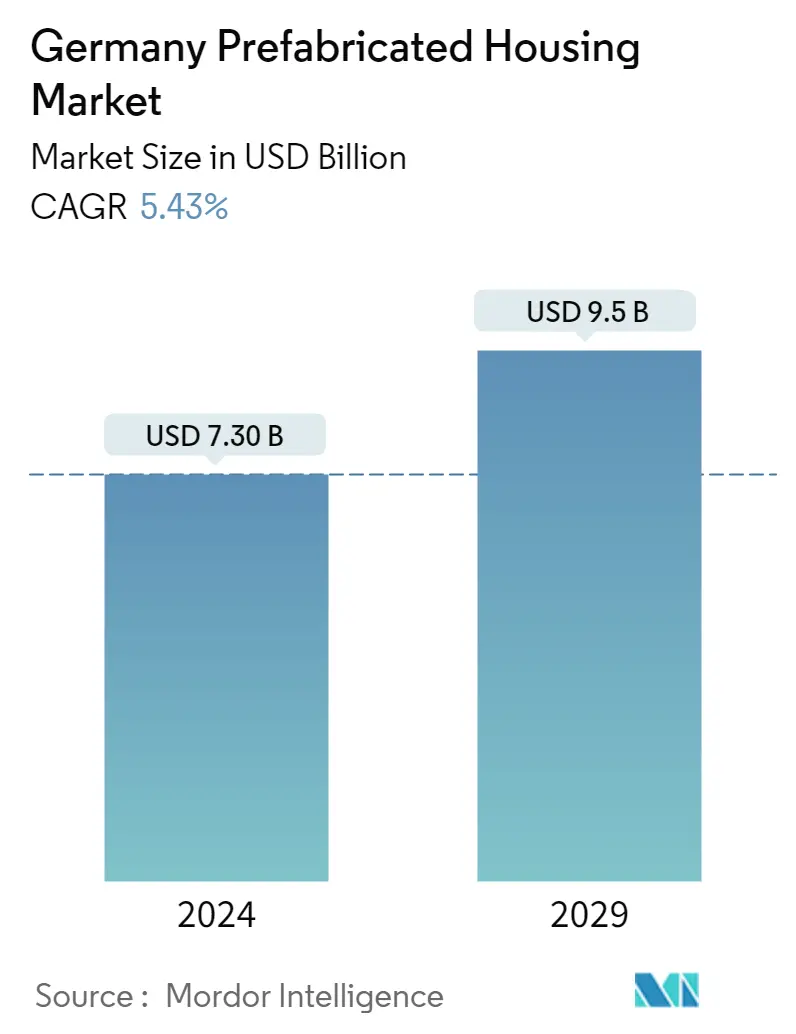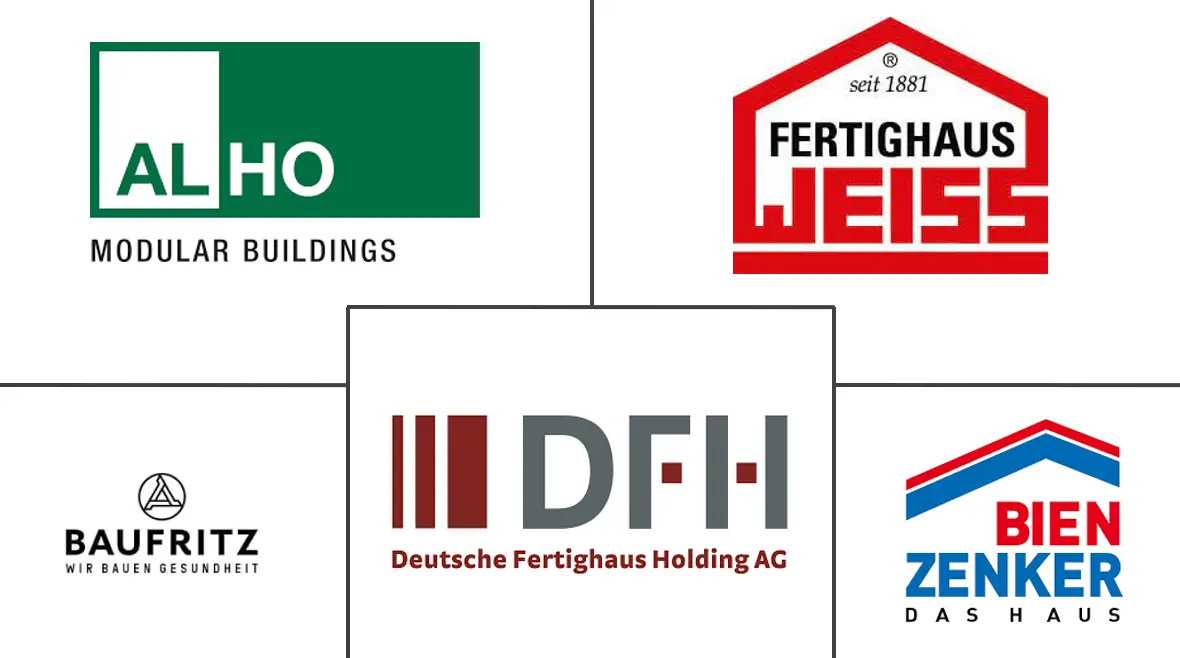Market Size of Germany Prefabricated Housing Industry

| Study Period | 2020 - 2029 |
| Base Year For Estimation | 2023 |
| Market Size (2024) | USD 7.30 Billion |
| Market Size (2029) | USD 9.50 Billion |
| CAGR (2024 - 2029) | 5.43 % |
| Market Concentration | Low |
Major Players
*Disclaimer: Major Players sorted in no particular order |
Germany Prefabricated Houses Market Analysis
The Germany Prefabricated Housing Market size is estimated at USD 7.30 billion in 2024, and is expected to reach USD 9.5 billion by 2029, growing at a CAGR of 5.43% during the forecast period (2024-2029).
- The COVID-19 pandemic slightly impacted the prefabricated housing market in Germany. Due to COVID-19 restrictions, many construction projects were delayed or canceled. However, despite the pandemic, 5,564 prefabricated houses were approved in Q1 2020, 12.8% more than in the same period last year. The overall market grew by just 2.1% to 24,108 newly approved one- and two-family houses.
- The rise in the overall construction industry and increasing prices are contributing to the increasing turnover of the prefabricated housing industry in Germany. In 2022, along with the general boom in residential construction in the country, the share of prefabricated housing solutions in residential construction increased, standing at more than 23%. Additionally, the high demand for turnkey or prefabricated houses and energy-efficient buildings contributes to the market's growth.
- Meanwhile, an increasing labor shortage is another factor driving the prefab construction role in the German residential market. In addition, industry experts say that modular production, coupled with modern digital processes, offers the opportunity to build a faster and more efficient structure while saving resources at the same time.
- In 2022, Saint-Gobain Germany acquired Brüggemann, a company specializing in the production of prefabricated wood-based solutions, to provide a complete range of sustainable solutions in the country. Thus, growing labor shortages, construction costs, and increasing concern about sustainability may drive prefabricated housing in Germany.
Germany Prefabricated Houses Industry Segmentation
Prefabricated homes, often referred to as prefab homes, are primarily manufactured in advance off-site, then delivered and assembled on-site. This report covers market insights, such as market dynamics, drivers, restraints, opportunities, technological innovation, its impact, Porter's five forces analysis, and the impact of COVID-19 on the market. In addition, the report provides company profiles to understand the competitive landscape of the market.
Germany's prefabricated housing market is segmented by type (single-family and multi-family). The report offers market size and forecasts in value (USD billion).
| By Type | |
| Single-family | |
| Multi-family |
Germany Prefabricated Housing Market Size Summary
The prefabricated housing market in Germany is experiencing a notable expansion, driven by several key factors. The sector has shown resilience despite challenges posed by the COVID-19 pandemic, which initially caused delays in construction projects. However, the demand for prefabricated houses has continued to rise, supported by the overall growth in the construction industry and the increasing prices of traditional building methods. The market is benefiting from a growing preference for energy-efficient and turnkey housing solutions, which are becoming more popular due to their sustainability and efficiency. The integration of modular production and modern digital processes is further enhancing the speed and resource efficiency of construction, addressing the labor shortages that are becoming more pronounced in the industry.
Germany's commitment to sustainability and net-zero targets is also propelling the adoption of prefabricated housing. The use of prefabrication in renovating outdated apartments and retrofitting inefficient buildings is gaining traction, with innovative technologies like 3D scanning and digital twins streamlining the process. The rising costs of conventional construction, driven by high demand for land and materials, are encouraging the shift towards prefabricated structures. The market is characterized by a fragmented landscape with numerous domestic and international players, and it is expected to grow as investments in prefabricated housing increase and major projects are initiated. Key companies in the sector include Deutsche Fertighaus Holding, Bien Zenker, ALHO Systembau GmbH, Baufritz, and Fertighaus Weiss GmbH, all of which are contributing to the market's expansion through strategic initiatives and innovations.
Germany Prefabricated Housing Market Size - Table of Contents
-
1. MARKET INSIGHTS
-
1.1 Current Market Scenario
-
1.2 Insights on Technological Trends
-
1.3 Insights on Supply Chain/Value Chain Analysis of the Prefabricated Housing Industry
-
1.4 Cost Structure Analysis of the Prefabricated Housing Industry
-
1.5 Insights on Different Types of Materials Used in Prefabricated Housing Construction
-
1.6 Impact of COVID-19 on the Market
-
-
2. MARKET SEGMENTATION
-
2.1 By Type
-
2.1.1 Single-family
-
2.1.2 Multi-family
-
-
Germany Prefabricated Housing Market Size FAQs
How big is the Germany Prefabricated Housing Market?
The Germany Prefabricated Housing Market size is expected to reach USD 7.30 billion in 2024 and grow at a CAGR of 5.43% to reach USD 9.50 billion by 2029.
What is the current Germany Prefabricated Housing Market size?
In 2024, the Germany Prefabricated Housing Market size is expected to reach USD 7.30 billion.

